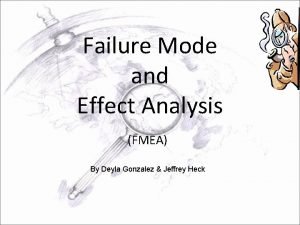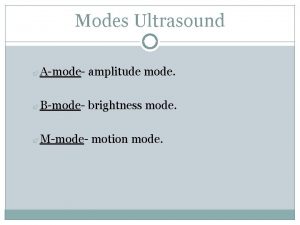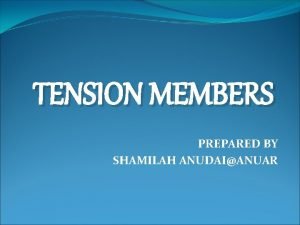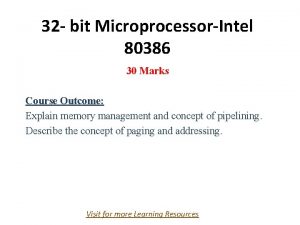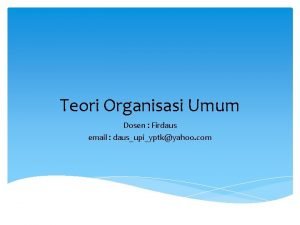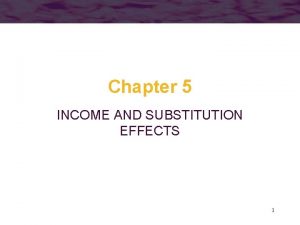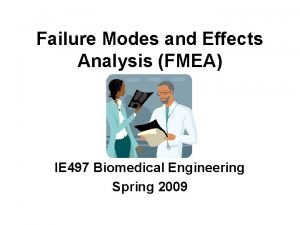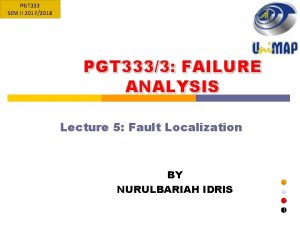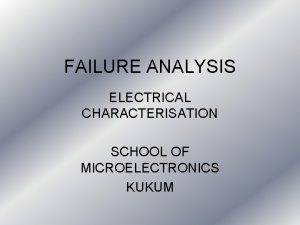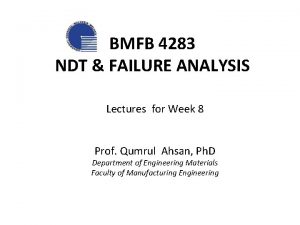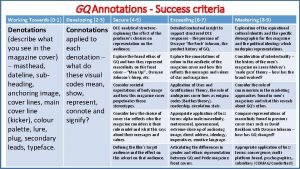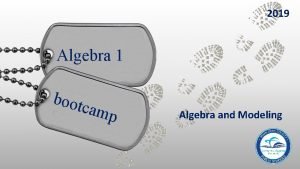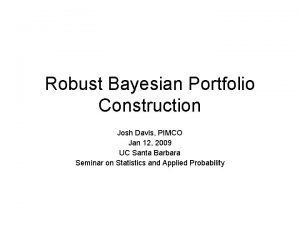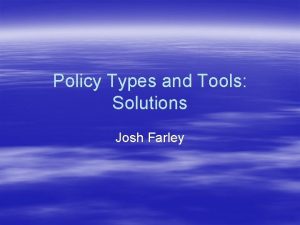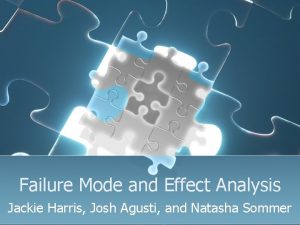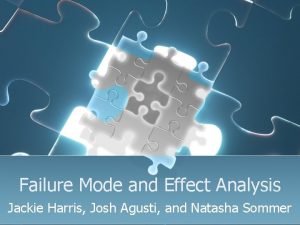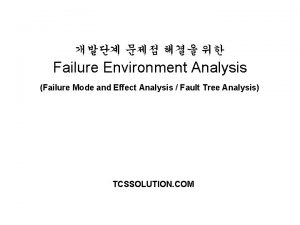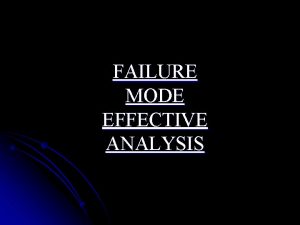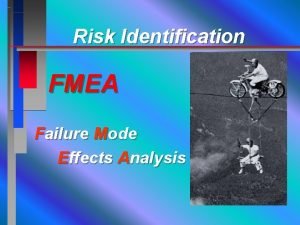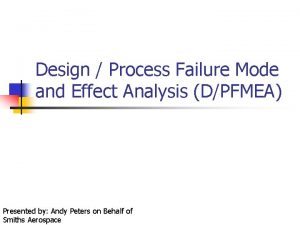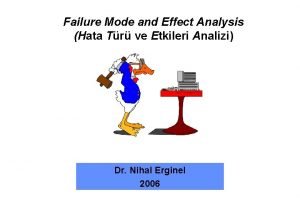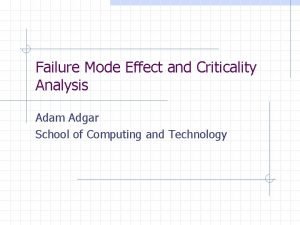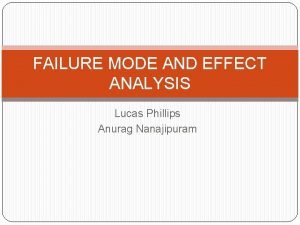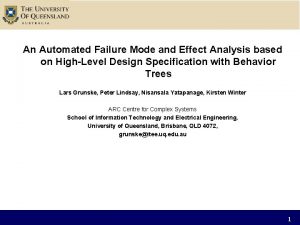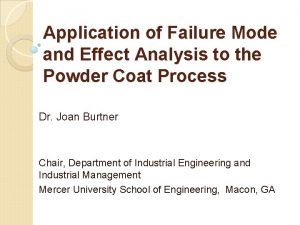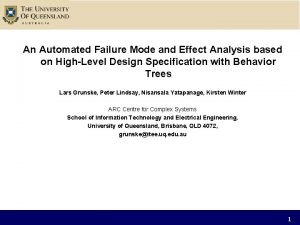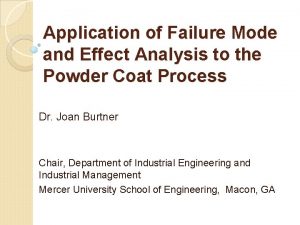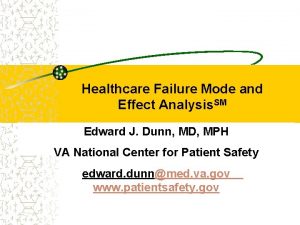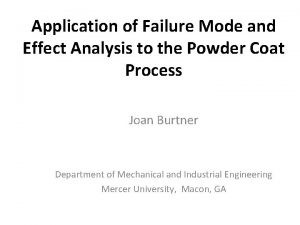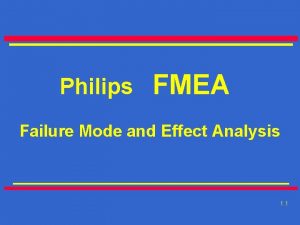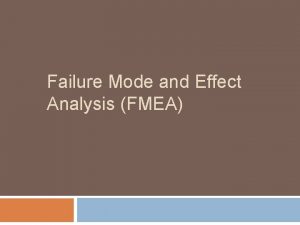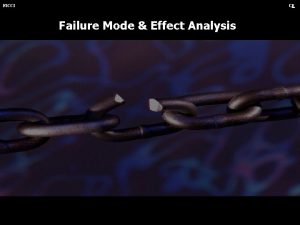Failure Mode and Effect Analysis Jackie Harris Josh


































- Slides: 34

Failure Mode and Effect Analysis Jackie Harris, Josh Agusti, and Natasha Sommer

Objectives What is FMEA? l Why is an FMEA important? l History of FMEA l Benefits of FMEA l Limitations of FMEA l How to conduct an FMEA? l

Who is in Attendance? Anyone conducted an FMEA before? l Anyone completed a Risk Analysis Procedure? l

What is FMEA? Failure Mode and Effect Analysis l A systemized group of activities designed to: ▪ recognize and evaluate the potential failure of a product/process and its effects ▪ identify actions which could eliminate or reduce the chance of potential failure ▪ document the process

Failure Mode and Effect Analysis l Simply put FMEA is: a process that identifies all the possible types of failures that could happen to a product and potential consequences of those failures.

FMEA Terms l Failure mode - the way in which something might fail l Effects analysis – studying the consequences of the various failure modes to determine their severity to the customer.

Why do an FMEA? Preventing problems is cheaper and easier than cleaning them up. l Some things are too risky or costly to incur mistakes. l

The Reasons for FMEA l l l l Get it right the first time Indentifies any inadequacies in the development of the product Tests and trials may be limited to a few products Regulatory reasons Continuous improvement Preventive approach Team building Required procedures

FMEA Provides the Potential to: Reduce the likelihood of customer complaints l Reduce the likelihood of campaign changes l Reduce maintenance and warranty costs l Reduce the possibility of safety failures l Reduce the possibility of extended life or reliability failures l Reduce the likelihood of product liability claims l

Benefits Identify potential and known failures l Reduce the number of engineering changes l Reduce product development time l Lower start-up costs l Greater customer satisfaction l Increased cooperation and teamwork between various functions l Continuous improvement l

History l l An offshoot of Military Procedure MIL-P-1629, titled Procedures for Performing a Failure Mode, Effects and Criticality Analysis, dated November 9, 1949. Used as a reliability evaluation technique to determine the effect of system and equipment failures. Failures were classified according to their impact on mission success and personnel/equipment safety. Formally developed and applied by NASA in the 1960’s to improve and verify reliability of space program hardware.

Concept FMEA l l l Used to analyze concepts in the early stages before hardware is defined (most often at system and subsystem) Focuses on potential failure modes associated with the proposed functions of a concept proposal Includes the interaction of multiple systems and interaction between the elements of a system at the concept stages.

Design FMEA Aid in the objective evaluation of design requirements and design alternatives l Aid in the initial design for manufacturing and assembly l Increase the probability that potential failure modes have been considered l Provide additional information to aid in the planning of efficient design testing l

Process FMEA l l l Indentify potential product related process failure modes Assess the potential customer effects of the failures Indentify the potential manufacturing causes on which to focus on Develop a ranked list of potential failure modes Document the results of the manufacturing

Types of FMEA

Resources Needed Commitment of top management l Knowledgeable individuals l Individuals attentive to FMEA timelines l People resources may be internal or external to the business or a combination of both l

FMEA Timing l FMEA should be updated: ▪at the conceptual stage ▪when changes are made to the design ▪when new regulations are instituted ▪when customer feedback indicates a problem

Advantages Enhance design and manufacturing efficiencies l Alleviate late change crises l Minimize exposure to product failures l Augment business records l Improve “bottom line” results l Add to customer satisfaction l

Limitations Employee training requirements l Initial impact on product and manufacturing schedules l Financial impact required to upgrade design, manufacturing, and process equipment and tools l ▪These limitations should be recognized and treated as short term and minimal interruptions to a business.

Risk Assessment Factors Severity (S): A number from 1 to 5, depending on the severity of the potential failure mode’s effect 1 = no effect 5 = maximum severity Probability of occurrence (O): A number from 1 to 5, depending on the likelihood of the failure mode’s occurrence 1 = very unlikely to occur 5 = almost certain to occur

Risk Assessment Factors Probability of detection (D): A number from 1 to 5, depending on how unlikely it is that the fault will be detected by the system responsible (design control process, quality testing, etc. ) 1 = nearly certain detention 5 = impossible to detect Risk Priority Number (RPN): The failure mode’s risk is found by the formula RPN = S x O x D. RPN = Severity x Probability of Occurrence x Probability of Detection. RPN will be a number between 1 (virtually no risk) and 125 (extreme risk).

Risk Priority Number

Procedures for FMEA Necessity Problem “Process Function” “Failure Mode” Effects How bad is it? “Severity” Causes How Likely? “Occurrence” Score Steps to Prevent

Procedures for FMEA Necessity Problem “Process Function” “Failure Mode” Put PB on bread Effects How bad is it? “Severity” Causes How Likely? “Occurrence” Score Steps to Prevent

Procedures for FMEA Necessity Problem “Process Function” “Failure Mode” Put PB on bread No PB Effects How bad is it? “Severity” Causes How Likely? “Occurrence” Score Steps to Prevent

Procedures for FMEA Necessity Problem “Process Function” “Failure Mode” Put PB on bread No PB Effects How bad is it? “Severity” Jelly Sandwich Causes How Likely? “Occurrence” Score Steps to Prevent

Procedures for FMEA Necessity Problem “Process Function” “Failure Mode” Put PB on bread No PB Effects How bad is it? “Severity” Jelly Sandwich 5/5 Causes How Likely? “Occurrence” Score Steps to Prevent

Procedures for FMEA Necessity Problem “Process Function” “Failure Mode” Put PB on bread No PB Effects How bad is it? Causes “Occurrence” “Severity” Jelly Sandwich 5/5 How Likely? Out of Stock Past Expiration Score Steps to Prevent

Procedures for FMEA Necessity Problem “Process Function” “Failure Mode” Put PB on bread No PB Effects How bad is it? Causes “Occurrence” “Severity” Jelly Sandwich 5/5 How Likely? Out of Stock Past Expiration 2/5 Score Steps to Prevent

Procedures for FMEA Necessity Problem “Process Function” “Failure Mode” Put PB on bread No PB Effects How bad is it? Causes 5/5 Score “Occurrence” “Severity” Jelly Sandwich How Likely? Out of Stock Past Expiration 2/5 10 Steps to Prevent

Procedures for FMEA Necessity Problem “Process Function” “Failure Mode” Put PB on bread No PB Effects How bad is it? Causes 5/5 Score Steps to Prevent 10 Check Pantry “Occurrence” “Severity” Jelly Sandwich How Likely? Out of Stock Past Expiration 2/5 Check Expiration Date

Conduct an FMEA Conduct a process FMEA on a paper airplane l Build a paper airplane l Conduct a design FMEA on your paper airplane l Paper Airplane Competition l

Conclusion What is FMEA? l Why is an FMEA important? l History of FMEA l Benefits of FMEA l Limitations of FMEA l How to conduct an FMEA? l

References Lean Six Sigma http: //www. leansixsigma. com/ l Stunell Technology http: //www. stunell. com/images/fmea. j pg l
 Failure mode and effect analysis
Failure mode and effect analysis A mode ultrasound
A mode ultrasound Digital design and computer architecture: arm edition
Digital design and computer architecture: arm edition Failure to sense
Failure to sense Failure to sense vs failure to capture
Failure to sense vs failure to capture Brittle fracture vs ductile fracture
Brittle fracture vs ductile fracture Tension
Tension Focus mode and diffuse mode
Focus mode and diffuse mode Difference between real protected and virtual mode of 80386
Difference between real protected and virtual mode of 80386 8088 vs 8086
8088 vs 8086 Whilst leila sleeps
Whilst leila sleeps My grandmother jackie kay analysis
My grandmother jackie kay analysis Keeping orchids poem
Keeping orchids poem My grandmother jackie kay analysis
My grandmother jackie kay analysis Billy elliot nan
Billy elliot nan Gap year jackie kay analysis
Gap year jackie kay analysis Jackie kay gap year
Jackie kay gap year Mode địa chỉ tức thì là mode
Mode địa chỉ tức thì là mode Operating modes of timer in 8051 microcontroller
Operating modes of timer in 8051 microcontroller Gartner mode 1 mode 2
Gartner mode 1 mode 2 Perbedaan (planning mode) dan (evolutionary mode)
Perbedaan (planning mode) dan (evolutionary mode) Chloride shift
Chloride shift Income effect graph
Income effect graph Failure point analysis
Failure point analysis Photo emission microscopy failure analysis
Photo emission microscopy failure analysis Curve tracing failure analysis
Curve tracing failure analysis Ndt failure analysis
Ndt failure analysis Pride magazine naomie harris analysis
Pride magazine naomie harris analysis #73 remember the titans
#73 remember the titans Jackie buys 3 hot dogs and 1 pretzel
Jackie buys 3 hot dogs and 1 pretzel Field tenor and mode in discourse analysis
Field tenor and mode in discourse analysis Statquest with john starmer
Statquest with john starmer Josh davis pimco
Josh davis pimco Josh farley
Josh farley Josh portman
Josh portman
